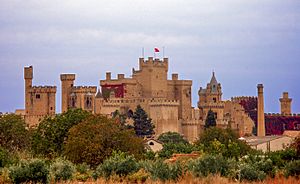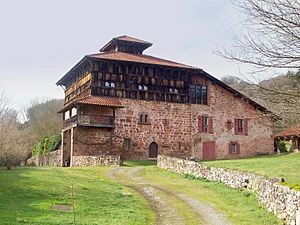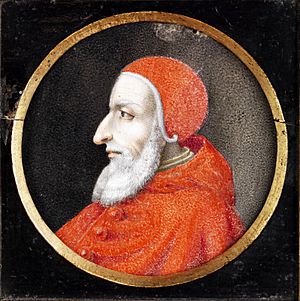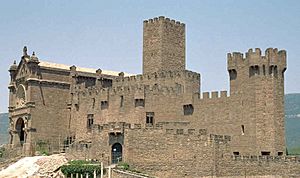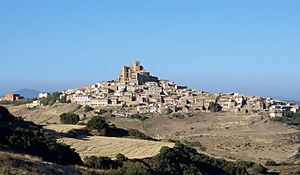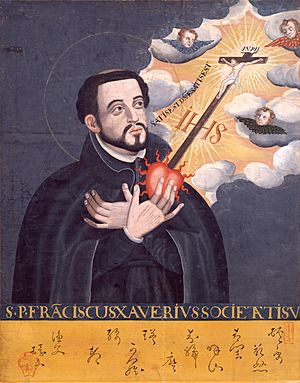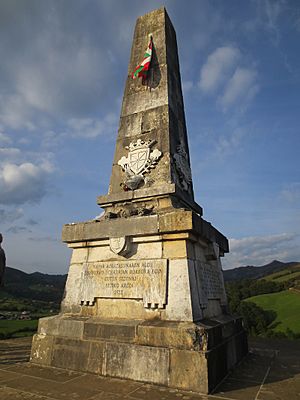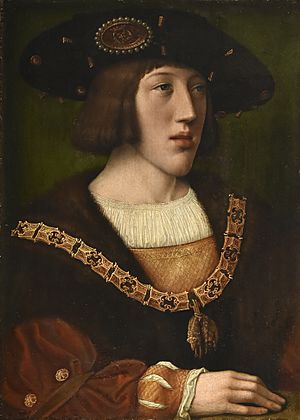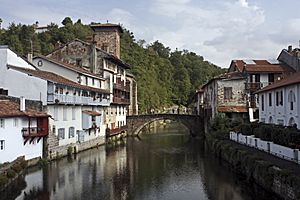Spanish conquest of Iberian Navarre facts for kids
Quick facts for kids Conquest of Navarre |
|||||||||
|---|---|---|---|---|---|---|---|---|---|
| Part of the War of the Holy League | |||||||||
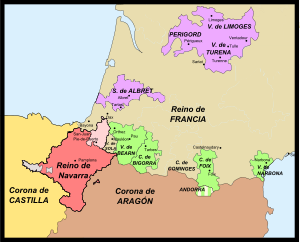 In red, the lands of Navarre occupied by Ferdinand. In pink, the remaining Kingdom of Navarre which survived until Louis XIII of France, II of Navarre. |
|||||||||
|
|||||||||
| Belligerents | |||||||||
| Commanders and leaders | |||||||||
| King Ferdinand II Duke of Alba Charles V, Holy Roman Emperor Duke of Nájera |
King John III Henry II of Navarre Pedro, Marshal of Navarre André de Foix |
||||||||
The Spanish conquest of Navarre was a series of military actions. It happened between 1512 and 1529. Ferdinand II of Aragon started the conquest. His grandson, Charles V, finished it.
In 1512, Ferdinand was King of Aragon. He was also in charge of Castile. The Pope created a group called the Holy League against France. Navarre tried to stay neutral, meaning they didn't pick a side. Ferdinand used this as an excuse to attack Navarre. France, Navarre's possible protector, was busy fighting other countries.
After the first invasion, there were a few attempts to take Navarre back. One small attempt happened in 1516. A bigger effort by France and Navarre happened in 1521. But Spanish forces defeated all these attempts. Fighting stopped in 1528. Spanish troops left the northern part of Navarre. In 1529, a peace treaty divided Navarre. The Pyrenees mountains became the border.
The part of Navarre taken by Castile was called Upper Navarre. The part north of the Pyrenees was called Lower Navarre. This northern part stayed an independent kingdom. It was ruled by the House of Albret. This kingdom had strong ties with France. It later joined France in 1620.
Contents
Navarre had many problems with its rulers since the mid-1400s. The nobles of Navarre were split into two fighting groups. These were the Beaumonts and the Agramonts. This caused trouble in the wider Basque Country. It also made Navarre easy for other countries to interfere with.
In 1461, Castilian troops invaded Navarre. Navarre lost some land and castles to Castile. Starting in 1474, King Ferdinand II of Aragon tried to control nearby kingdoms. He used alliances and military force. He made Navarre a protectorate of Castile in 1476. This meant Castile protected and controlled Navarre. But other people also wanted to rule Navarre. The Count John of Foix wanted the crown too.
Royal Marriages and Alliances
The Queen of Navarre, Magdalena of France, tried to keep a balance. She used diplomacy from 1483. King Ferdinand II looked for allies among Navarre's nobles. He found one in Louis of Beaumont. Ferdinand also tried to arrange a marriage. He wanted the young Queen Catherine to marry a Spanish prince. But Magdalena stopped this plan.
In 1484, John III of Navarre became King of Navarre. He was a Gascon noble. This stopped Ferdinand's plans again. In 1488, Alain of Albret, John's father, supported an alliance against France. This alliance included Castile-Aragon and England. Alain signed treaties with Ferdinand. These included military agreements to defend Navarre against France.
In 1494, Catherine and John were crowned in Pamplona. This happened after an agreement with Ferdinand. But the Count of Lerin did not accept this. He started a revolt. The King and Queen wanted to defeat him. They needed to control all the castles in the kingdom.
Ferdinand warned Navarre not to get military help from Bearn. The Navarrese rulers could not defeat the rebellious count. He still held several castles. By 1495, the King and Queen had pushed him out of the kingdom. They gained control of many castles. They also got the support of the Navarrese parliament. Peace treaties between Navarre, France, and Castile-Aragon brought four years of stability.
Peace and New Conflicts
After Queen Isabella of Castile died in 1504, Ferdinand married Germaine of Foix. She was a French princess. Any children from this marriage could claim the Navarre throne. Ferdinand also wanted to annoy his son-in-law, Philip. Philip was the new King of Castile.
Catherine and John III supported Philip. This made them stronger. But it also made them enemies with King Louis XII of France. In 1507, Ferdinand was in charge of Castile again. The Count of Lerín, Ferdinand's ally, revolted. But Catherine and John III refused to pardon him.
In 1507, Cesare Borgia was killed by Beaumont knights. This happened during a fight for Viana. In 1508, the King and Queen attacked the Count's rebellion. They defeated Louis. This brought a short time of peace to Navarre. The parliament of Navarre ended the Brotherhood of Navarre in 1510. They said that justice was working well.
King Louis XII's Plans
Ferdinand and King Louis XII of France became friends. Louis XII wanted the Albrets' lands outside Navarre. But the Albrets refused to give them up. In 1507, Navarre sent diplomats to France. They tried to improve relations.
Louis XII wanted the Albrets' territories. He used the Parliament of Toulouse to try and take them. In 1510, the Navarrese parliament decided to create a joint defense. This was to protect against outside attacks. Ferdinand II again looked for allies among the Beaumont party in Navarre.
Getting Ready for Invasion
In 1510, the international situation changed. Pope Julius II was a very ambitious Pope. He had formed a Holy League against Venice in 1508. Then, the Pope and France went to war. On August 4, 1511, Julius II declared a new Holy League against France. He sided with King Ferdinand. Navarre refused to join and stayed neutral.
Ferdinand II declared war on France in March 1512. A month later, Gaston of Foix died. This meant Ferdinand's wife, Germaine of Foix, could claim the Albrets' lands.
King Louis became more friendly with Queen Catherine and King John III. He dropped his demands for their land. Catherine and John III also talked with Ferdinand. Ferdinand used both offers and threats. He moved troops to Navarre's borders. In February 1512, Ferdinand allied with England. This led to military action in France. The Navarrese prepared their defenses. Ferdinand planned to invade Navarre. He also planned to use a papal order from Pope Julius. This order would say the Navarrese rulers were against the Church. Castilian diplomats worked for months to get this from Rome.
The Spanish Invasion of 1512
In June 1512, things became tense. The Holy League asked to send English and Castilian troops through Navarre to France. At the same time, Navarre was talking with Louis XII in France. Ferdinand threatened to cross the border if an agreement was made. These talks led to a treaty on July 18, 1512. It said Navarre would remain neutral. It also highlighted the English threat to France.
The next day, Ferdinand sent his troops into Navarre. They were led by General Don Fadrique de Toledo, Duke of Alba. He had helped conquer Granada. Before this, a Gipuzkoan militia had already entered Navarre. They captured Goizueta on July 10.
In a few days, Castilian troops reached Pamplona. They faced no resistance. Ferdinand's ally, Count John of Beaumont, hosted the troops. The invading army had 6,000 experienced soldiers. The total group was 15,000. Pamplona had fewer than 10,000 people. Catherine and John III left for Tudela. They hoped to gather loyal troops. But they only found 500.
The Spanish army was too big. The loyalists went east to Lumbier and then to Lower Navarre. Catherine, John III, and their troops retreated to Orthez in Béarn. Pamplona's outer walls were weak. The Duke of Alba threatened to loot the town. The local leaders surrendered on July 25. Castilians sent messages to other castles in Navarre. They demanded they surrender too. Most did, except for Amaiur (Baztan), Estella-Lizarra, Tudela, and Saint-Jean-Pied-de-Port.
Pamplona's leaders had to promise loyalty to Ferdinand. But they said they had already promised loyalty to John III. He was their true king and was still alive. In late August 1512, Ferdinand claimed he was the rightful King of Navarre.
Tudela was surrounded. It fought against the Aragonese attack. Alfonso of Aragon led the attack. He was Ferdinand II's son and archbishop of Zaragoza. He had 3,000 foot soldiers and 300 horsemen. The people of Tudela were loyal to their king. But they had low spirits because of the Pope's order. They knew resistance was hopeless. The town surrendered by September 9, 1512. This was to avoid being looted. Alfonso promised to respect Navarre's laws.
Spanish Control of the Kingdom
By late August 1512, almost all of Navarre was under Spanish rule. The Duke of Alba's army occupied the Pyrenean valleys. They crossed the mountains northwards. They surprised Roncevaux and burned the village. Castilian forces reached Saint-Jean-Pied-de-Port on September 10. Its defenders were leaving the castle. The Castilian forces looted and burned villages in Lower Navarre. The Castilian commander tried to justify this. The Church seemed to approve of controlling the Navarrese people.
The Castilians demanded that all lords in Lower Navarre surrender. The Duke of Alba ordered all tower houses in the area to be torn down. Orchards in Saint-Jean-Pied-de-Port were cut down. This left the local people struggling for food. Ferdinand demanded that Catherine and John III surrender. He offered to let them keep the throne. But only if their son, Henry, was raised in the Castilian court. They refused this demand.
A French army was in Bayonne. They were watching for English or Castilian moves. Ferdinand still planned to invade Guyenne. This was home to the Albrets' lands and French royal lands. But time was running out for the Castilians in Lower Navarre. They were short on food and supplies. The weather was also bad. 1,000 unhappy veteran soldiers in Saint-Jean-Pied-de-Port mutinied. The Duke of Alba moved them to a safer area. This ended the uprising.
By mid-October, John III had an army of 15,000 soldiers. They were Navarrese, Gascons, and German mercenaries. They were ready to attack. Three groups moved into Gipuzkoa and Navarre. The first group attacked Hondarribia and Donostia. They took over several small towns. This was to distract Castilian forces. The English had decided to leave the war. They were tired of Ferdinand II.
The second group had 8,000 Gascons, 1,000 Navarrese, and 1,500 German mercenaries. They were led by the Duke of Longueville. They defeated the Castilians on October 19. The third group crossed the Pyrenees. They reached Burgui. The Duke of Alba was afraid his communications with Pamplona would be cut. He pulled back to the capital. He left soldiers in Saint-Jean-Pied-de-Port. The Navarrese group moved towards Pamplona.
When the Navarrese army approached, Estella-Lizarra revolted. The fortress of Monjardin also revolted. On October 24, 1512, the Duke of Alba reached Pamplona. Navarrese loyalist forces followed him. They surrounded the capital.
In Estella-Lizarra, the Navarrese fought against Pedro de Beaumont's forces. He was supported by Castilians. The Navarrese leaders made a final stand at Monjardin fortress. But they eventually surrendered. The siege of Pamplona lasted a month. But winter came, and Castilian reinforcements arrived. This ended any hope of success. The loyalists retreated. Castilian troops went back across the Pyrenees. They went to Saint-Jean-Pied-de-Port and Lower Navarre. They had small fights with unhappy Beaumont party lords.
On December 7, 1512, a group of Navarrese soldiers was escorting cannons. They met a patrol led by Juan de Silva. This happened at the Belate pass. The Gipuzkoan militia attacked the soldiers. The soldiers retreated and were mostly killed. This small fight was later made into a big battle. The cannons taken were added to the official coat of arms of Gipuzkoa in 1513.
Spanish Reoccupation
By December 1512, fighting was only in Saint-Jean-Pied-de-Port. Castilians still occupied it. From March 13 to 23, 1513, the Parliament of Navarre met. Only Beaumont party members were there. They accepted Ferdinand as their "natural lord and king." Ferdinand promised to keep Navarre's institutions and identity. The first Castilian viceroy, Diego Fernández de Córdoba, promised to respect Navarre's laws, called fueros.
At first, Navarre was given to Ferdinand. It was seen as something he had "earned." Aragon was a Pyrenean kingdom. It had a similar government system. Castile was more authoritarian. Castile pushed for Navarre to be given to Joanna of Castile, Isabella's daughter. Navarre was then joined to Castile in 1515. On June 11, 1515, the Cortes of Burgos met. No Navarrese representatives were there. Even the Count of Lerin, Ferdinand's helper, protested. He was put in prison. Ferdinand confirmed the annexation on July 7. He promised to respect Navarre's laws. But he also gave the Royal Council of Castile power over Navarre.
Castile and Navarre had different legal systems. They also had different people. Once the Spanish armies controlled all the castles, they started to take over the government. This caused many problems. Niccolò Machiavelli, a famous writer, thought Ferdinand would easily make peace with France. He believed Ferdinand would keep Navarre and give up other lands.
Building the Case for the Conquest
Legal Reasons for Invasion
Ferdinand wanted his military action to seem right. He asked legal experts to write a report. These experts were Antonio de Nebrija and Juan López de Palacios Rubios. They made many claims about why Ferdinand had the right to Navarre. For many years, these reports were used in debates about the conquest. These scholars were working for King Ferdinand II and the Duke of Alba. López de Palacios later wrote about why Spain could conquer lands in the Americas.
In late August 1512, after conquering Navarre, Ferdinand made a statement. He said he had the right to attack Navarre. This was based on the "fair war" idea from the Roman Church in 1511. With Pamplona captured, Ferdinand also claimed he had a right to the Crown of Navarre. Another claim was that he needed to cross Navarre to reach Guyenne. He said this was his divine right as a king. Ferdinand also claimed he was "following international treaties" by invading Navarre to help England.
He also claimed that the Navarrese rulers were not the true heirs. He said the rightful heirs were from the Visigothic Kingdom. Finally, Ferdinand made claims to the Navarre throne through his marriage to Germaine of Foix. He also claimed it through his father, John II of Aragon.
The Pope's Role
Ferdinand had spies. They told him about the talks between Navarre and Louis XII. On July 17, 1512, Ferdinand spread a fake copy of the treaty. This was to make both sides look bad. The Pope's ruling, Pastor Ille Caelestis, came out on July 21. This was three days after the invasion started. It allowed Ferdinand to fight enemies of the Church. It also let him claim their lands outside Italy. This applied to France and "heretic" Navarre. Ferdinand had pushed for this rule in December 1511.
On June 5, 1512, Ferdinand wrote to Pope Julius II. He asked the Pope to declare that everyone in Navarre was excommunicated. He wanted the Pope to give him Navarre. Or at least the right to take it. He said, "You just need a scroll and ink." On June 7, Ferdinand wrote again. He urged his ambassador to get the orders quickly. He said, "our army is up and the artillery ready" to invade Navarre.
However, the Pope's order did not directly name Navarre. The Exigit Contumatium papal order came out six months later, on February 18, 1513. Catherine and John III were called schismatic. This meant they were against the Church. They were excommunicated, and their property was taken. The members of the Parliament of Navarre who met in Pamplona in March 1513 accepted Ferdinand II as king.
| While the ambition to conquer kingdoms is absolutely not without fault, as the kings should rather protect their borders instead of invading foreign ones, however, it sometimes happens that they are compelled by necessity to undertake an evidently necessary war, which would otherwise be unfair (...), but since it would be worse that the wicked prevail over the righteous, very appropriately that necessity makes most rightful an otherwise unfair case |
| Antonio de Nebrija. 1545 (posth.). De bello Navariense. |
New Rule Over Old Ways
Ferdinand had the Pope's support. But he was still worried about being called a tyrant. This affected Navarre's status after the invasion. Ferdinand tried to make the invasion seem like a simple change of rulers. He wanted to hide that it was a military takeover. Even though Navarre was seen as "earned," Ferdinand promised to respect Navarre's laws.
Navarre was not like Granada. Granada was seen as a rightful conquest. Navarre was an old Christian kingdom. It had its own government and people. The kingdom was seen as stronger than the crown itself.
A Chance After Ferdinand's Death
By 1516, Ferdinand had died. His grandson, Charles of Austria, became king of Castile and Aragon. Charles was 16 years old. He was still living in the Netherlands. John III of Navarre saw this as a chance to take back Navarre. He gathered an army in Sauveterre-de-Bearn. It had two groups. One was led by himself, the other by Pedro, Marshal of Navarre. This small army wanted to reach Sanguesa and Lumbier. They hoped to start a rebellion against the Castilians there.
The first group, led by John III, could not defeat the Castilian soldiers in St-Jean-Pied-de-Port. The second group was also unsuccessful. Pedro moved towards Roncevaux on March 12, 1516. But Cardinal Cisneros knew about Navarre's plans. He had Colonel Villalba waiting at Roncevaux.
Pedro decided to avoid Roncevaux. He went through Salazar and Roncal. But bad weather and little support from local people weakened his group. His 600-strong group was attacked and defeated near Isaba. The survivors were taken prisoner.
Failed Expedition and Aftermath
Many lords were captured. This included Valentin of Jaso, a cousin of Francis Xavier. The prisoners were taken to Atienza. They were kept in chains. No Navarrese were allowed into the town. Anyone helping a Navarrese person would be fined and imprisoned. The remaining 7 Navarrese Agramont lords were eventually released. They promised to surrender. But they all joined the 1521 French-Navarrese expedition.
The attempt to take back Navarre failed. On August 14, 1516, the Treaty of Noyon was signed. This was between Francis I of France and Charles V. Charles agreed to rethink his rights over Navarre. He also agreed to listen to Queen Catherine's messengers. But tensions between France and Spain grew again. Catherine died in early 1517. The parts of the treaty about Navarre were never put into action.
Talks continued between Navarrese diplomats and Charles V. They tried to arrange a marriage. Charles' sister Eleonor would marry the new king of Navarre, Henry II. The Parliament of Navarre in Pamplona, only with Beaumont party members, asked for "Coastal Navarre" to be rejoined to Upper Navarre.
Cisneros' Actions Under Charles V
The Spanish cardinal Cisneros was acting as a temporary ruler for King Charles. In 1517, he ordered all Navarrese castles to be torn down. This was to stop future resistance. Important Navarrese figures who supported their kings were imprisoned or forced to leave. Cisneros wanted to "subjugate and constrain [Navarre]." He wanted to make sure no one dared to rebel again.
In 1516, Spanish authorities ordered the forced conversion or expulsion of Navarrese Muslims. This happened in and around Tudela. But by 1516, many had already left. Muslims left Navarre until 1520. Many settled in Aragon. They found temporary safety there until they were expelled in 1526.
| [...] Don Pedro de Navarra, who would not swear Charles as his king, [...] because he was not born in Spain, nor a member of the royal house of Castile by his father's line, so he should not swear to him, and that he was forced to keep this faith as a good gentleman, that one given to Don Juan de Labrit and Doña Catalina, the owner of Navarre, and his homeland. |
| – Pedro de Navarra, Marshal of Navarre, declining in prison Charles V's offer to join the Imperial forces (circa 1520)[1] |
Navarre's government structure stayed the same after the 1512 invasion. When Ferdinand II of Aragon died, the Parliament of Navarre met. They asked Charles V, who was 16, to come for a coronation. But Charles was not interested. He refused to attend any ceremony. He said he was "happy" with the proposal. The Parliament met in 1517 without Charles V. The Duke of Najera represented him.
Charles made many promises. The Parliament kept sending complaints and demands for damages. There were 67 of them. The second viceroy of Navarre was removed in 1515. This was probably for passing on the complaints. Documents about Charles' promise in 1516 show they might have been changed.
| Navarrese reconquest attempt | |||||||
|---|---|---|---|---|---|---|---|
| Part of the Italian War of 1521–1526 | |||||||
|
|||||||
| Belligerents | |||||||
| Commanders and leaders | |||||||
| Antonio Manrique de Lara, 2nd Duke of Nájera | General Asparros Don Jaime Velaz de Medrano, Alcaide and Mayor of Amauir-Maya |
||||||
In 1520 and 1521, Castile was busy with the Revolt of the Comuneros. The Crown of Aragon also had money problems. So, Spain seemed like an easy target for King Francis I of France. Meanwhile, the young King Henry II of Navarre, who was in Béarn, saw a way to take back Navarre.
Henry worked with France. He started gathering a 12,000-strong army. Most were Gascons and Navarrese exiles. This French-Navarrese army was led by General Asparros. It had 12,000 foot soldiers, 800 mounted knights, and 29 cannons.
The Castilian Viceroy of Navarre, Antonio Manrique de Lara, 2nd Duke of Nájera, was surprised. He was supposed to guard the lands taken in 1512. But he had moved most of his troops to Castile. He was trying to stop the Revolt of the Comuneros. Rumors of a "French" invasion were common.
The Navarrese were angry about Castile taking over their government. They rose up to support Henry II. Volunteer groups formed to kick out the Castilians. As the French-Navarrese army neared Pamplona, the citizens revolted. They surrounded the Castilian military governor, Ignatius of Loyola, in his new castle. The soldiers surrendered after a few days in May 1521. This was at the Battle of Pampeluna (Pamplona). In less than three weeks, all of Navarre was taken back.
But not everything was settled. Henry II's absence worried the people. Also, General Asparros's troops looted Viana. This made many people angry and disappointed. The army was supposed to free them. The French-Navarrese army then moved into Castile. They crossed the Ebro. They surrounded Logroño. The count of Lerin was there with 4,000 soldiers.
Castilian Counterattack
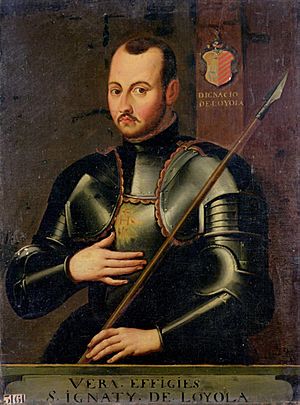
Unfortunately for the King of Navarre and the French, the Revolt of the Comuneros had been crushed in April. The Castilian government could send its soldiers back to Navarre. Many Castilian nobles who had supported the rebels now wanted to prove their loyalty. Many towns that were once rebellious also sent soldiers to Navarre.
A large Castilian army of 30,000 men approached Navarre. On June 11, Asparros stopped his siege of Logroño. He retreated back to Tiebas, in Navarre. Asparros desperately asked for more soldiers from Béarn. But Henry II refused. He probably didn't want to risk them in a battle that was likely already lost.
The French-Navarrese were completely defeated. This happened at the Battle of Esquiroz (Noáin) near Pamplona. It was on June 30, 1521. The French-Navarrese army did not have enough cannons. They were outnumbered by more than two to one. French and Navarrese losses were over 6,000 dead. General Asparros was captured. He was released after paying a large ransom. Pamplona also surrendered.
Castilian deaths were between 50 and 300. After the victory, the Navarrese faced abuse and looting. Many lords switched sides to the Castilians. The Castilians kept sending more soldiers. This was because Charles V and France were at war across Europe.
Hondarribia and the Last Stand at Amaiur
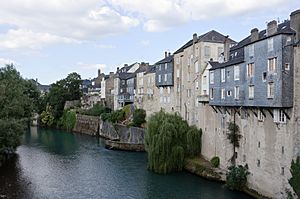
After the defeat at Noain, Henry II of Navarre and Francis I of France allied again. This time they attacked the northern edges of Navarre. They probably thought the Spanish were tired from fighting. In late September 1521, the French-Navarrese split into two groups. They moved towards the Bidasoa river.
The first group was based in Labourd. It had Navarrese, Normans, and Gascons. The second group started from Saint-Jean-Pied-de-Port. It was held by troops loyal to Henry II. This group had German, Gascon, and Norman foot soldiers. A total of 27,000 fighters were led by Guillaume Gouffier, seigneur de Bonnivet. Most of the troops came from the lands of Foix-Albret. After taking Roncal, the second group went west. They captured Roncevaux.
The French-Navarrese army approached the fortress of Amaiur (Baztan, Navarre). They surrounded the fortress. The Castilians had just made it stronger. On October 3, 1521, the Castilians surrendered. They were allowed to leave for Castile. Guillaume Gouffier's troops then went to Labourd. They captured the fortress of Urantzu. Then they surrounded the coastal stronghold of Hondarribia (Fuenterrabía). This stronghold was captured on October 12, 1521. The French-Navarrese controlled the area from Belate to the Bidasoa river.
In May 1522, Charles V was in Pamplona. Spanish forces started gathering money and troops. In July 1522, Amaiur was about to fall. The Emperor landed in Santander with 4,000 German mercenaries. Many Basques from Biscay, Gipuzkoa, Álava, and Navarre joined Charles V's forces. Some Aragonese also joined. Before the Castilian expedition to the Bidasoa, Gipuzkoan militias fought the French-Navarrese. This was at the fortress of Urantzu. It was called the Battle of San Marcial. The pro-Imperial forces took the position on June 30, 1522.
Fall of Amaiur
Charles V made military plans. He also issued a pardon for many exiled Agramont party members. These were loyal to Henry II. Charles V seemed to use Ferdinand II's tactics. The pardon was mixed with punishment. He ordered more Navarrese fortresses to be torn down. He also put Agramont leaders on trial for treason.
On July 4, 1522, a 7,000-strong Castilian expedition left Pamplona. By July 15, Amaiur was surrounded. The fortress was defended by 200 loyal Navarrese knights. They were led by Don Jaime Velaz de Medrano. He was one of the 1512 leaders of Estella-Lizarra. But no help arrived. The fortress fell to the Count of Miranda on July 19, 1522. A monument now stands at the site of the fortress. After Amaiur surrendered, orders were given to destroy the fortress. They also burned houses of Agramont supporters.
The 39 surviving Navarrese defenders of Amaiur were taken to Pamplona. They were held captive. Besides Jaime Velaz de Medrano, they included his son Luis. Miguel de Jaso, lord of Xavier, and Francis Xavier's oldest brother were also there. Miguel escaped dressed as a woman. He joined his brother John de Jaso. They were with the 3,000 soldiers in Hondarribia. This group included Claude of Lorraine.
Charles V's Push North
At the height of Francis' and Henry II's campaign, the Navarrese king made a symbolic move. He called the Estates of Navarre in Saint-Palais. They met on August 18, 1523. The king promised to respect the Navarrese laws (fueros). He reorganized the Navarrese government. Charles V felt his power in Navarre was being challenged. He planned to defeat Henry II and Francis. He also wanted to stop Navarrese resistance. His plan was to invade Lower Navarre, Toulouse, Bayonne, and Hondarribia.
The Viceroy of Aragon advanced to Oloron in Béarn. He surrounded the town. The army of the Prince of Orange failed to take Bayonne. He was frustrated. On his way back south, he destroyed Ustaritz. He also looted Biarritz and Saint-Jean-de-Luz. Other towns near the Navarre-Béarn border were also destroyed. Finally, the Imperial forces focused on capturing Hondarribia. On December 15, 1523, Charles V issued a new pardon. This included most of the Navarrese Agramont leaders. But 152 important figures were not pardoned. Some of them were still fighting in Hondarribia.
Political Agreements
The Battle of Hondarribia lasted until April 1524. On February 19, 1524, the Navarrese forces surrendered. They were led by Pedro de Navarra. He was the son of the assassinated Navarrese marshall. On April 29, Charles issued a final general pardon. The defenders of Hondarribia left after almost two years. The pardon was confirmed on May 3. This happened at a ceremony in Burgos. The Navarrese leaders were promised their properties back. But only after they promised loyalty to Charles V. Some defenders were given positions in Charles V's court. Their properties were partly or fully returned. But there were problems. With this surrender, Navarrese resistance to Spanish rule ended.
Small military fights were now only in the southern parts of Lower Navarre. In 1525, a Spanish attack captured St-Jean-Pied-de-Port again. The Spanish held it for almost two years. But in 1527, the lord of Luxe and Esteban de Albret recaptured it. Except for a Spanish outpost, the region was abandoned in 1528. This was because Charles V lost interest. It was also hard to defend. France lost the wider war. King Francis and Henry II were captured in February 1525. This sealed the division of Navarre. Henry II escaped from prison. But treaties in 1526 and 1529 confirmed Spanish control over the Iberian part of Navarre. Francis I promised not to help Henry II.
What Happened After the Conquest?
Changes in Government
Charles V's pardons were meant to help Navarre join Habsburg Spain. Pardons were also given to clergy who had supported the Navarrese kings. But distrust of the Navarrese continued for a long time. This was while independent Navarre existed north of the Pyrenees. Lands taken from people loyal to Henry II started to be returned. But the process was difficult. There were legal problems. Leaders of the Agramont party faced harsh sentences.
Many books, records, and archives from before 1512 are missing. These include legal documents and property titles. They relate to the period from the mid-1400s to the early 1500s. Records start again in 1512. These files seem to have been taken by the Spanish monarchy. Most of the people spoke Basque. They could not read or write. They relied on notaries who could write in Romance or Latin. But a new rule said property titles had to be re-registered with Castilian officials. If not, ownership was invalid. The property could be taken by the occupiers.
Navarre remained under military occupation until at least 1530. All government positions were taken by Castilian appointees. This included bishops, viceroys, and administrative staff. Pamplona and other Navarrese towns had Castilian soldiers. Navarrese church leaders were stopped from becoming abbots or higher. Navarrese people who were very submissive were sometimes kept as officials.
After the Spanish conquest, whenever a bishop position was empty, the Navarrese asked for a Navarrese bishop. But they never got one. For example, in 1539, a report asked for a native church leader. One reason was that he could speak Basque. He would be obeyed by his people. This was because "the Basque people, the main part of the kingdom, love like no other nation their own nature and language." The report was rejected. A Castilian bishop was appointed. Historians say this was the "Castilian assimilation of Navarrese Church." They even call it a colonial system.
Religious Issues and Witchcraft Trials
The Navarrese kept looking to their Protestant relatives in Henry II's independent Navarre. Navarre became a place where Protestant ideas spread early on. In 1521, the Inquisition seized and burned many books. It was forbidden to read them. It was also forbidden to write or preach against Protestant ideas. This was to avoid drawing attention to their claims.
In 1525, after Henry II's failed campaigns, the first witchcraft accusations started. A member of the Royal Council, Balanza, started them. He was a commissioner for witchcraft inquiries. He wrote to the Castilian bishop of Pamplona. Balanza said there was "so much evil" in some southern Pyrenean valleys. These valleys were near the fighting in Lower Navarre. After his inquiry and trials, 30-40 people were condemned. Most were women. They were burned alive by the occupation authorities. Other sources say 200 people. Another 43 people lost their property.
On August 15, 1532, Ana of Albret, Henry II's sister, died. She wanted to be buried with her parents in Pamplona. But her wish was not honored. She also left her title as Princess of Viana to her brother King Henry II. Charles V worried about the occupation of Navarre until he died. He tried to find a way to please both himself and the Navarrese monarchs. He tried to marry his son, Philip II of Spain, to Henry II's heir, Jeanne d'Albret, in 1539. These attempts failed. But Charles V told Philip II in his will to give Navarre back. He said to do it "following his conscience." This never happened.
See also
 In Spanish: Conquista de Navarra para niños
In Spanish: Conquista de Navarra para niños



